Porsche Supercup
The Porsche Supercup (officially known as Porsche Mobil 1 Supercup, known as Porsche Michelin Supercup prior to 2007)[1] is an international One-make GT3 production stock car racing premier series supporting the Formula One World Championship organized by Porsche Motorsport GmbH.
 The official logo of Porsche Mobil 1 Supercup | |
| Category | One-make GT3 production stock car racing by Porsche |
|---|---|
| Country | International |
| Inaugural season | 1993 |
| Drivers | 16 |
| Teams | 6 |
| Constructors | Porsche |
| Engine suppliers | Porsche |
| Tyre suppliers | Michelin |
| Drivers' champion | |
| Teams' champion | |
| Official website | porsche.com/international |
Porsche Supercup drivers compete in identical Porsche 911 GT3 Cup cars. On average, 24 race cars take part in each race. Most circuits visited by the series are European, although circuits in Bahrain, United Arab Emirates, the United States and Mexico have been included in the calendar as well.
History
Since 1993 the Porsche Michelin Supercup has run as support to the FIA Formula 1 World Championship. The number of races has grown from the original nine to total 13 in 2006, although decreasing to 11 in 2017.
Racing cars
Chassis
Porsche Supercup cars adhere to a rear-engined rear-wheel-drive design. A roll cage serves as a carbon-fibre space frame chassis and is covered by a multiple-gauge sheet metal body. They have a closed cockpit, fenders, a rear wing, and an aerodynamic splitter. Each team may purchase cars and engines from other teams.
The front suspension is a McPherson suspension strut design, while the rear suspension is a multi-link live axle design utilizing trailing arms. Brake discs must be made of steel and may not exceed 380 mm (15 in) diameter. The only aerodynamic components on the vehicles are the front splitter, rear wing, solid polycarbonate glass window in the windows only, and side skirts. The use of rear diffusers, vortex generators, canards, wheel well vents, hood vents, and undertrays is strictly prohibited. While the cars may reach speeds of about 200 mph (320 km/h) on certain tracks.
Porsche Supercup cars are required to have at least 1 working windshield wiper installed on the car for all tracks as a part of the road racing rules package.
Engine
The cars are powered by gasoline direct-injected flat-six Porsche engines since 1993 with compacted graphite aluminium alloy blocks and DOHC valvetrains actuating four-valves per cylinder, and are limited to 3,996 cc (244 cu in) of displacement. However, modern technology has allowed power outputs near 485 hp (362 kW) in unrestricted form while retaining the conventional basic engine design. In fact, before Porsche instituted the gear rule, Porsche Supercup engines were capable of operating more than 8,000 rpm. The current Porsche MDG.G Supercup engines curb weight is roughly at over 410 lb (186 kg).
Evolution of Porsche Supercup cars
911 Cup (Type 964)
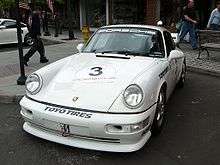
For the inaugural 1993 Porsche Supercup season the 964 Cup (used in Carrera Cup from 1992) based on the 964 Carrera RS (itself based on the earlier 1990 964 Carrera Cup) was the vehicle of choice. Compared to the road car the Cup race car features a similarly stripped-out interior and retains the catalytic converter, 18 inch magnesium wheels and ABS but was lowered by 20mm, featured a full roll cage and no passenger seat.
911 Cup 3.8 (Type 993)

Based on the 993 Carrera 2 and used in the Porsche Supercup for seasons 1994–1997. Updated in 1995 with aero parts from the new Carrera RS, followed by a five-horsepower increase to 315 PS (232 kW; 311 hp) at 6,200 rpm in 1996. 216 units were produced in total.
911 GT3 Cup (Type 996)
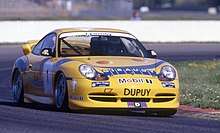
Raced in the Porsche Supercup seasons 1998–2001. Basis for the upcoming 996 GT3 road car, featuring a 3.6 litre boxer engine on basis of the GT1 block. For the 1999 season the engine output was increased to 272 kW (370 PS; 365 bhp) and 370 N⋅m (273 lbf⋅ft) at 6,250 rpm. The car managed the 0-100 km/h (62 mph) sprint in four seconds, with a top speed of 286 km/h (178 mph). For the 2001 season the GT3 Cup received modified aerodynamics including an enlarged rear wing and improved cooling.[2][3]
911 GT3 Cup (Type 996 II)
Raced in the Porsche Supercup seasons 2002–2004. For 2002 the GT3 Cup received several changes based on the 996.2 Carrera and Turbo models, including Turbo-style headlights. The new body significantly improves aerodynamics and cooling. Engine output is increased to 280 kW (381 PS; 375 bhp) and 380 N⋅m (280 lbf⋅ft), further changes include improved transmission cooling, a lightened exhaust system and other light-weighing measures across the car.[4] For the 2004 season the car received further upgrades. Engine output is once again increased slightly, to 287 kW (390 PS; 385 bhp) at 7,200 rpm and 390 N⋅m (288 lbf⋅ft) at 6,500 rpm. Gear ratios of fourth, fifth and sixth gears have been shortened. An 89-litre fuel tank improves endurance racing capabilities. In the interior changes are made to enable the use of the HANS device.[5]
911 GT3 Cup (Type 997)
Raced in the Porsche Supercup seasons 2005–2009. The 997-based Cup car features significantly improved aerodynamics and lightweight CFRP parts, including doors, rear body panels, engine deck lid and rear wing. Parts of the suspension are adopted from the GT3 RSR.[6]
911 GT3 Cup 3.8 (Type 997 II)
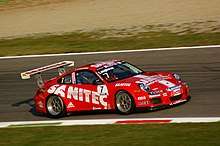
Raced in the Porsche Supercup seasons 2010–2012. Based on 997.2 GT3 RS, the car features a new 3.8 litre engine, an enlarged rear wing adopted from 911 GT3 Cup S measuring 1.70 m (67 in), additional Unibal joints on the track control arms and front and rear sword-shaped anti-roll bars with seven position settings each and a steering wheel mounted Info Display with 6 switches. The vehicle was unveiled at the 2009 Frankfurt Motor Show and deliveries began in the same year. The base MSRP of the European model was €149,850 (before tax).[7][8]
911 GT3 Cup (Type 991)

Based on the Porsche 911 GT3 type 991, this 911 GT3 Cup was used in the Porsche Supercup for the seasons 2013–2016.
911 GT3 Cup (Type 991 II)
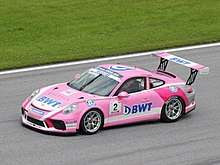
Raced in the Porsche Supercup since the 2017 season. Based on the latest 911 GT3 road car it features a larger 4.0-litre flat-six boxer engine, improved aerodynamics and an enlarged escape-hatch in the roof and is priced at €189,900 excluding taxes.[9]
Cockpit and safety components
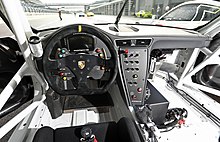
For the safety equipment, all Porsche Mobil 1 Supercup cars seating utilizes racing bucket driver's seat with 6-point seat belts. The steering wheel of all Porsche Mobil 1 Supercup cars are made exclusively in-house by Porsche Motorsport GmbH. All Porsche Mobil 1 Supercup cars are also equipped with Cosworth Omega Intelligent Colour Display units since 2013 season. The fire extinguisher of all Porsche Mobil 1 Supercup cars are included in the bottom right-hand side underneath. The interior rear-view mirror is still currently used since 1993 until present.
The cockpit of all Porsche Mobil 1 Supercup cars are fully protected by doors, windshields and roofs (shielded by polycarbonate glass for windscreen, side windows and rear windows including also windshield wipers for rain weather only in the windscreen) because of current coupé-type car.
Fuel and motor oil
Fuel
ExxonMobil has been an official control fuel retailer and convenience store partner for all Porsche Supercup entrants since 1996 season under Mobil brand in 1996 until 2006 later ExxonMobil brand in 2007 until 2014 and later Esso brand since 2015 until present. The current fuel type of Porsche Supercup is Esso Synergy™ Racing Fuel 98 RON 100% unleaded racing gasoline without any other renewable fuel blends like Ethanol and Methanol (the same fuel as it used by Red Bull Racing Formula One team).
Previously Shell was the official fuel partner of Porsche Supercup since 1993 until 1995 season.
Motor oil
Mobil 1 also has been official motor oil partner of Porsche Supercup since 1996 season and utilizing Mobil 1 Racing fully synthetic 0W-40 racing lubricant to improve fuel economy and extending engine life. Previously Shell was the official motor oil partner of Porsche Supercup since 1993 until 1995 season.
Tyres
Michelin has been a current tyre partner of Porsche Supercup since 2002 season. Previously Pirelli supplied the tyres for all Porsche Supercup cars since 1993 until 2001 season. The tyre model of Michelin Porsche Supercup tyre utilizing Porsche Cup N2 sub-brand. The Michelin Porsche Supercup tyre compounds are dry slick and full-treaded rain tyres.
The current tyre sizes of Porsche Supercup Michelin tyres are 27/65-R18 on the fronts and 31/71-R18 on the rears.
Specifications
1993
1994–1997
1998–2001
- Engine displacement: 3,600 cc (220 cu in) naturally-aspirated flat-six
- Bore × stroke: 100 mm × 76.4 mm
- Power output: 265 kW (360 PS; 355 bhp) at 7,200 rpm, 360 N⋅m (266 lbf⋅ft) at 6,250 rpm
- Redline: 8,000 rpm
- Gearbox: 6-speed manual transmission
- Tyres: Pirelli slick; "245/645-18" front, "305/645-18" rear
- Brakes: 330 mm brake disks front/rear, ABS standard
- Fuel tank capacity: 64 L (14 imp gal; 17 US gal)
- Weight: 1,140 kg (2,513 lb)
- Fuel: Mobil unleaded
2002–2004
- Engine displacement: 3,600 cc (220 cu in) naturally-aspirated flat-six
- Bore × stroke: 100mm × 76.4mm
- Power output: 280 kW (381 PS; 375 bhp) at 7,200 rpm, 380 N⋅m (280 lbf⋅ft) at 6,250 rpm
- Gearbox: 6-speed manual transmission
- Tyres: Michelin slick; "24/64-18" front, "27/68-18" rear
- Brakes: 350 mm brake disks front/330 mm rear, ABS standard
- Fuel tank capacity: 64 L (14 imp gal; 17 US gal)
- Weight: 1,140 kg (2,513 lb)
- Fuel: Mobil unleaded
2005–2009
- Engine displacement: 3,598 cc (220 cu in) naturally-aspirated flat-six
- Power output: 294 kW (400 PS; 394 bhp) at 7,000 rpm, 400 N⋅m (295 lbf⋅ft) at 6,500 rpm
- Bore × stroke: 100 mm × 76.4 mm
- Redline: 8,200 rpm
- Gearbox: 6-speed sequential manual transmission
- Tyres: Michelin slick; "24/64-18" front, "27/68-18" rear
- Brakes: 380 mm front/350 mm rear brake disks
- Wheelbase: 2,355 mm (93 in)
- Track (front/rear): 1,515 mm (60 in)/1,780 mm (70 in)
- Weight: 1,120 kg (2,469 lb)
- Fuel: Mobil later ExxonMobil unleaded
2010–2012
- Engine displacement: 3,797 cc (232 cu in) naturally-aspirated flat-six
- Power output: 331 kW (450 PS; 444 bhp) at 7,500 rpm
- Redline: 8,500 rpm
- Gearbox: 6-speed sequential manual transmission
- Wheels & Tyres: Michelin slick; "24/64-18" on 9.5Jx18 front, "27/68-18" on 12Jx18 rear
- Brakes: 380 mm front/350 mm rear brake disks
- Weight: 1,160 kg (2,557 lb)
- Fuel: ExxonMobil High Performance unleaded
2013–2016
- Chassis: Carbon-fibre monocoque with safety roll cage
- Engine displacement: 3,800 cc (232 cu in) naturally-aspirated flat-six box
- Bore × stroke: 102.7 mm × 76.4 mm
- Power output: 338 kW (460 PS; 453 bhp) at 7,500 rpm
- Redline: 8,500 rpm
- Fuel: ExxonMobil High Performance (2013-2014) later Esso Synergy™ Racing Fuel (2015-2016) unleaded 98 or 103 RON (the same fuel used by McLaren Formula One team)
- Gearbox: 6-speed paddle-shift sequential semi-automatic transmission dog-type gearbox with reverse
- Wheels & Tyres: Michelin Porsche Cup N2 dry slick and treaded rain; "24/64-R18" on 9Jx18 ET28 front, "27/68-R18" on 11Jx18 ET53 rear
- Brakes: 380 mm front/rear brake disks, no ABS (can be retrofitted)
- Fuel tank capacity: 100 litres (22 imperial gallons; 26 US gallons) FIA FT3
- Length: 4,547 mm (179 in)
- Width: 1,851 mm (73 in)
- Height: 1,280 mm (50 in)
- Wheelbase: 2,458 mm (97 in)
- Weight: 1,200 kg (2,646 lb)
- Safety equipment: Schroth 6-point seat-belt + HANS device + racing bucket seat with fore/aft adjustment + windshield wipers
2017–present
- Chassis: Carbon-fibre monocoque with safety roll cage
- Engine: Porsche Motorsport MA1.76 (2017) later MDG.G (2018–present)
- Displacement: 3,996 cc (244 cu in) naturally-aspirated flat-six boxer
- Bore × stroke: 102 mm × 81.5 mm (4.02 in × 3.21 in)
- Power output: 357 kW (485 PS; 479 bhp) @ 7,500 rpm
- Torque: 480 N⋅m (354 lbf⋅ft) @ 6,250 rpm
- Redline: 8,500 rpm
- Fuel: Esso Synergy™ Racing Fuel 98 RON super unleaded (the same fuel used by Red Bull Racing Formula One team)
- Lubricants: Mobil 1 Racing 0W-40 fully-synthetic motor oil
- Fuel delivery: Gasoline direct injection
- Gearbox: 6-speed paddle-shift sequential semi-automatic transmission dog-type gearbox with reverse
- Wheels & Tyres: Michelin Porsche Cup N2 dry slick and treaded rain; "27/65-R18" on 10.5Jx18 ET28 front, "31/71-R18" on 12Jx18 ET53 rear
- Brakes: 380 mm front/rear brake disks, no ABS (can be retrofitted)
- Fuel tank capacity: 100 litres (22 imperial gallons; 26 US gallons) FIA FT3
- Length: 4,564 mm (180 in)
- Width: 1,980 mm (78 in) incl. mirrors
- Height: 1,246 mm (49 in)
- Wheelbase: 2,456 mm (97 in)
- Weight: 1,200 kg (2,646 lb)
- Safety equipment: Schroth 6-point seat-belt + HANS device + racing bucket seat with fore/aft adjustment + windshield wipers
Regulations
Two sets of slick tyres may be used per car and weekend. The number of wet tyres is unlimited. The tyres are identical for all competitors and are not permitted to be pre-warmed or chemically treated.
Championships
Driver championship
Points are assigned to the first 15 finishers of each race and all races count. To receive points a driver must compete in multiple races per season. Since 2008, there have been two bonus points awarded for the driver who secures pole position in qualifying.
| Position | 1st | 2nd | 3rd | 4th | 5th | 6th | 7th | 8th | 9th | 10th | 11th | 12th | 13th | 14th | 15th | Pole |
|---|---|---|---|---|---|---|---|---|---|---|---|---|---|---|---|---|
| Points | 20 | 18 | 16 | 14 | 12 | 10 | 9 | 8 | 7 | 6 | 5 | 4 | 3 | 2 | 1 | 2 |
If in the case of a tie, Porsche Supercup will determine the champion based on the most first-place finishes. If there is still a tie, Porsche Supercup will determine the champion by the most second-place finishes, then the most third-place finishes, etc., until a champion is determined. Porsche Supercup will apply the same system to other ties in the rankings at the close of the season and at any other time during the season.
Team championship
The points of the two best drivers of each team are added up. At the end of the season Porsche rewards the three best placed teams with prize money.
Prize money
In 2006 and 2007, Porsche AG pays around 820,000 euros to drivers and teams. Per race the winner receives 9,000 euros, the runner-up 7,500 euros and the third placed driver 6,500 euros. For a 15th place 1,400 euros are paid. Additionally, the 2006 or 2007 champion receives a Porsche road car. The driver with the fastest laps will be given a premium watch from Porsche Design.
In 2015, Porsche says it pays "more than 730,000 Euros in prize money to drivers and teams. In addition, the overall winner receives a special prize. The winner of the rookie classification receives an additional prize of 30,000 Euros providing he/she reregisters for the following year’s Porsche Mobil 1 Supercup."[10]
Champions
Dutch driver Patrick Huisman is the most successful driver in the tournament, having won four straight titles between 1997 and 2000, followed by René Rast with three titles and Jeroen Bleekemolen and Richard Westbrook with two titles each. The reigning champion is the German driver Michael Ammermüller, who has also won three back-to-back titles, in 2017, 2018, and 2019.
Popularity
At the Grand Prix circuits during 2006 an average of 125,000 spectators witnessed the action from the grandstands at each round. According to Porsche AG races attracted 22 million TV viewers worldwide, most of them in Europe where Eurosport provides regular coverage.[11]
Porsche Carrera Cup
Porsche also runs many regional and national one-make production stock car racing tournament around the globe.
- Porsche Carrera Cup Asia
- Porsche Carrera Cup Italy
- Porsche Carrera Cup Japan
- Porsche Carrera Cup Australia
- Porsche Carrera Cup France
- Porsche Carrera Cup Germany
- Porsche Carrera Cup Great Britain
- Porsche Carrera Cup Scandinavia
- Porsche GT3 Cup Challenge Brazil
- Porsche GT3 Cup Challenge Australia
- Porsche GT3 Cup Challenge Benelux
- Porsche GT3 Cup Challenge Canada
- Porsche GT3 Cup Challenge Finland
- Porsche GT3 Cup Challenge Japan
- Porsche GT3 Cup Challenge Middle East
- Porsche GT3 Cup Challenge Suisse
- Porsche GT3 Cup Challenge USA
- Porsche GT3 Cup Trophy Argentina
- Porsche GT3 Cup Trophy China
- Porsche GT3 Cup Trophy USA
References
- "ExxonMobil Named Title Sponsor of Porsche Supercup". Archived from the original on 2009-05-28. Retrieved 2007-03-05.
- "98-00 – 911 GT3 – Story". racecam.de. Archived from the original on 2018-08-02. Retrieved 2018-08-02.
- "2001 – 911 GT3 Cup – Story und Facts". racecam.de. Archived from the original on 2018-08-02. Retrieved 2018-08-02.
- "2002 – 911 GT3 Cup – Story und Facts". racecam.de. Retrieved 2018-08-02.
- "2004 – 911 GT3 Cup – Story und Facts". racecam.de. Retrieved 2018-08-02.
- "2006 – 911 GT3 Cup – Story und Facts". racecam.de. Archived from the original on 2018-08-02. Retrieved 2018-08-02.
- Joseph, Noah (2009-08-26). "Pavlov's Bell: Porsche reveals, prices new 911 GT3 Cup racer ahead of Frankfurt debut". Autoblog.com. Retrieved 2010-12-14.
- "2008 – 911 GT3 Cup – Story und Facts". racecam.de. Archived from the original on 2018-08-02. Retrieved 2018-08-02.
- "New 911 GT3 Cup with ultra-modern drive" (Press release). Porsche. 2016-09-29. Retrieved 2017-03-09.
- "Porsche Mobil 1 Supercup". Porsche AG. Retrieved 6 June 2015.
- "Porsche Mobil 1 Supercup website". Retrieved 2007-03-05.